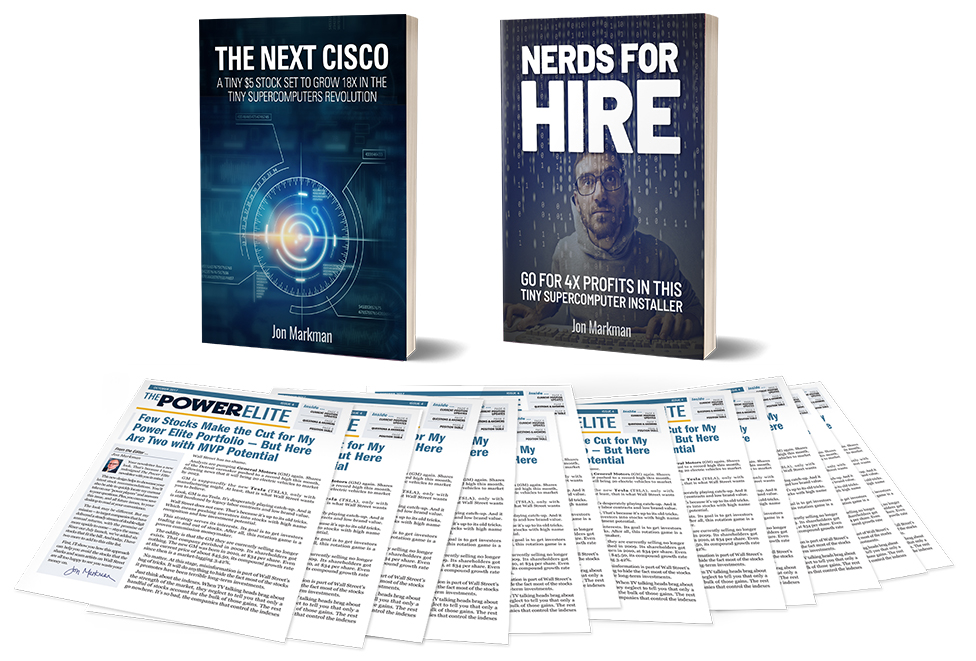Massive revolution started in
$5 trillion retail sector …
A rollout even bigger than smartphones —
with huge profits of 1,800% possible
for investors in one tiny $5 stock
Picture this…

You’re out on the town for the afternoon. You’re hungry. You see a small corner store, and you step inside, swiping your phone or credit card as you enter.
You head for the snacks. You look at a few, then pick a bag of chips. Then you grab an apple, plus a drink.
As you’re about to leave, you see a rack of gift cards and remember your nephew’s birthday is coming up and you wanted to get him something. You figure $25 for Amazon is good, so you grab that, and throw it in your pocket.
Then, you walk out.

No lines. No cash or credit cards. You don’t even have to wait while a too-slow cashier scans your items one … by one … by one … by one.
As you step outside, you’re not looking over your shoulder, worried you’ll be caught for shoplifting. What you did was completely legal. Encouraged. Expected.
Because as you walked through the store, “tiny supercomputers” recognized which items you picked up, which you put back, and even the specific gift card you put in your pocket.
Then, as you simply walked out of the store, you were charged for each item you took and your gift card was activated.
And before you’re even a block away, your phone notifies you of a new email that includes an itemized receipt for everything you got.
Hi, my name is Jon Markman, and what you’re about to hear could save America’s entire “brick and mortar” retail sector.
In fact, it’s already triggering a massive wave of investment back into Main Street retail.
You’re about to discover just how big this is. How this revolution is transforming the $5-trillion-plus American retail industry.
And, how it’s already making investors rich. One tiny $5 stock providing crucial technology to this “tiny supercomputer” revolution just doubled in price. And — as you're about to see — it’s just getting started.
The time to get in on this is now. I’ll show you how …
Now here’s the shocker:
This is NOT an Amazon Go store …
Maybe you’ve seen the headlines:
“Amazon Said To Plan Up To 3,000 Cashierless Stores By 2021”
— Bloomberg
“The Impact of 3,000 Amazon Go Stores Will Be Massive”
— Forbes
“Amazon Considering Go Tech At Larger Stores Reveals Future Of Retail”
— Business Insider
But what I’ve just described is NOT an Amazon Go store. Nor is it one of their new larger retail spaces meant to more closely mimic grocery stores like Whole Foods. I’ll tell you what store it is in a moment, but first, understand ...
- What the media is missing is the massively-bigger opportunity outside of Amazon.
- What the media is missing is that this isn’t about Amazon at all.
- What the media has missed so far is that the technology behind these stores — especially a critical element I call “tiny supercomputers” — is already starting a massive revolution across the entire $5-trillion American retail industry (and beyond).
And I believe the story the media isn’t telling yet is far more interesting. And could be far more profitable for you, as an investor.
In fact, I see an opportunity to multiply your money up to 18-times in one little $5 stock. As the world wakes up to what could be the biggest transformation in the history of retail. And then as this revolution spreads to industry after industry.
Tiny supercomputers will be
the biggest tech revolution
of the 2020s …
Desktop computers transformed how businesses operated in the 80s. The internet in the 90s. E-commerce in the 2000s. Cloud computing in the 2010s.
Every single one of these rewrote the rules of modern business — and made forward-thinking investors a fortune.
And today we’re on the verge of a tiny supercomputer revolution that industry insiders suggest could be the biggest transformation — and profit opportunity — of them all.
Better yet: we are just getting started. This will be the biggest tech play of the next decade. And there are just a handful of companies whose technologies are at the center of this massive economic revolution.
And this won’t require you to be a Silicon Valley insider, or a company founder, or even a big-money accredited investor to get in.
Even a small investment in a publicly-traded stock could make you rich. As long as you get in to the trend just as it’s beginning — now.
That’s been the secret to getting rich in every major tech revolution of the last 20 years …
It’s like investing in Microsoft
in the desktop computer revolution …
If you would’ve invested $10,000 in Microsoft in 1986, it would’ve been worth over $600,000 within the next ten years ...

That’s an extraordinary 60-times return on your money.
It’s like investing in Cisco
as the world connected to the internet …
$10,000 invested in Cisco in 1990 would’ve been worth over $2.4 million a decade later, just after the dot-com peak …

That one investment would’ve multiplied your money 240-times.
What would you do with 240-times the retirement savings you have today?
And heck, if you didn’t wait the full decade and cashed out early, your $10,000 investment could have turned into a whopping $4-million-plus in cold, hard cash.
It’s like investing in Amazon
through the rise of e-commerce …
If you would’ve bought Amazon after the dot-com bust in 2002, you could’ve turned every $10,000 into more than $230,000 in ten years ...

And that’s just a 10-year period.
I’ve watched from the front lines here in Seattle — and in my portfolio — as Amazon’s share price rose an exceptional 15,600% since the early 2000s.
That’s enough to turn that same $10,000 investment into over $1.5 million.
It’s like investing in Salesforce
as it led the way into cloud computing ...
Cloud computing was just kicking off in 2005, as the upstart Salesforce.com was making headlines for putting business software on the internet.
If you’d caught that tech revolution then, putting $10,000 into their stock, it would’ve multiplied 18-times, to more than $180,000, by 2015. And that’s even with the worst financial crisis of our lives smack-dab in the middle of that holding period.

This one investment could’ve multiplied your money 18-times over. And it’s the smallest of the examples I’ve given you. Showing just what’s possible when you invest in the right tech stock, at the beginning of the biggest tech trends.
Which is exactly what I believe you have the opportunity to do again, with this tiny $5 stock …
Just one investment
could make you a fortune ...
It happens over and over again, by getting in the right stocks at the beginning of a massive new tech trend.
As an investor and tech enthusiast, I’ve long been a fan of NVIDIA.
Their tech was in the right place at the right time for three separate trends: the massive growth of the gaming industry, plus artificial intelligence, plus cryptos.
Investors who got into NVIDIA early could’ve seen a $10,000 investment climb as high as $750,000 in 2018 …
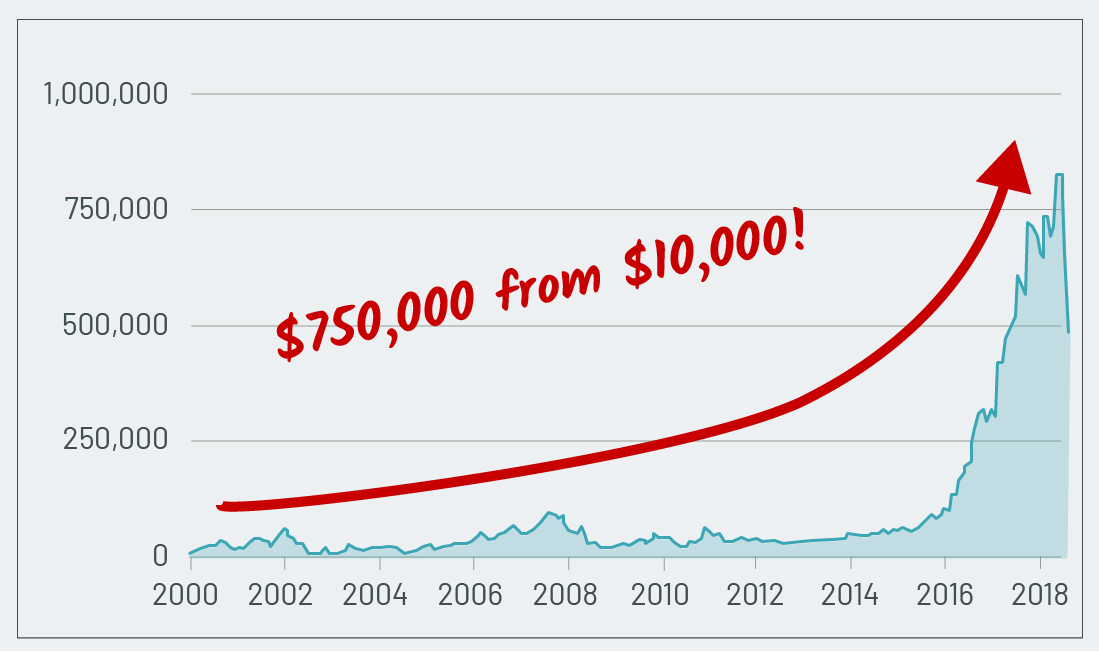
Sure, their share price dipped into the end of 2018, but that $10,000 would still be worth $450,000, if you didn’t sell.
This is the power of finding the right stock to ride these massive trends.
And I’m convinced the $5 stock I want to share with you today could be your best way to go for these kind of gains from the tech revolution sparked by tiny supercomputers.
I’ll give you the link to all the details in a moment. First, you deserve to know where I’m coming from — and why I can speak with such authority on this new tech …
Here’s my insider’s secret to
tomorrow’s tech revolutions …
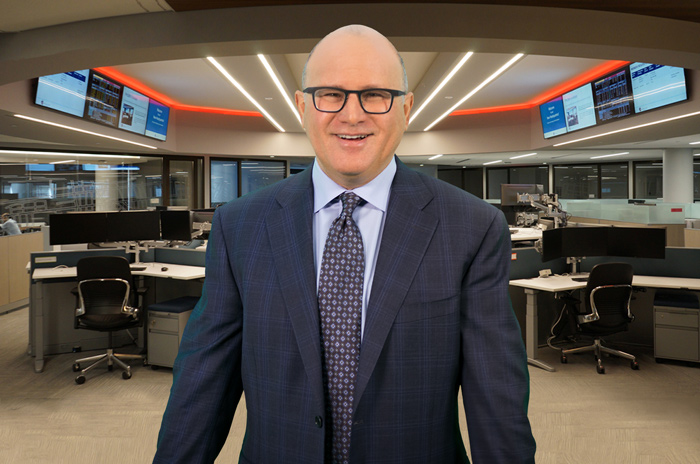
As I said, my name is Jon Markman. I’m a Seattle-based tech industry expert.
Today, my office is in Seattle’s prestigious Union Square towers. That’s a mile on foot from Amazon’s corporate headquarters in downtown Seattle. Just over half a mile from the third Amazon Go store. And mere blocks away from the famous Pike Market, home of the very first Starbucks store.
I moved to Seattle in the dot-com boom, when I was recruited to work under Bill Gates at Microsoft and build MSN Money.
I came from a financial journalism background. Though unlike many reporters, I was able to parlay that into actionable investment strategies.
At Microsoft, I designed the stock-picking algorithms behind the famous StockScouter — the world’s first online stock-rating system. And built stock picking models that have delivered as much as 423% per year.
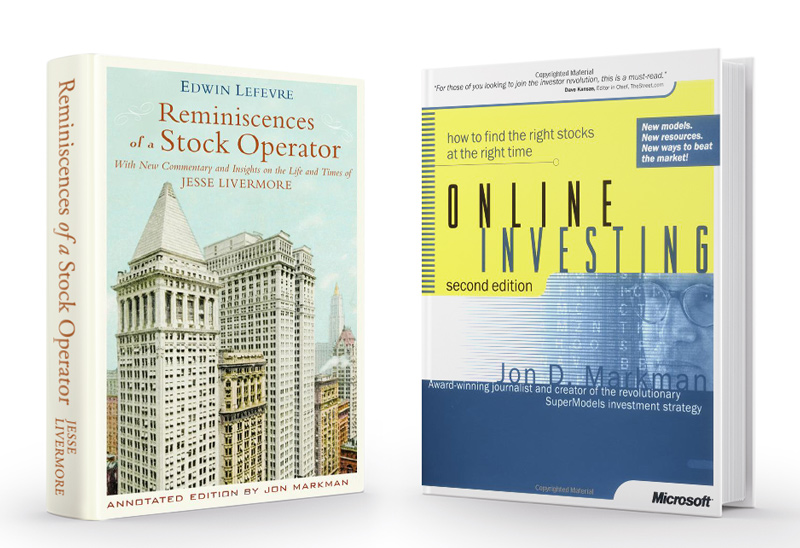
I’ve also published two bestselling books on investing. I introduced the world to Online Investing back in 1999. And more recently, I published the annotated edition of Reminiscences of a Stock Operator — with a foreword from hedge fund titan Paul Tudor Jones.
For most of the last three decades, I’ve effectively been a bridge between west coast tech and the investment world.
I’ve become a trusted confidante of Wall Street traders, top tech execs, Silicon Valley money, and other insiders. Many of whom I met while building MSN Money. They tell me what’s coming and I share it with the world.
You may have seen my expert perspective on technology and investing in Forbes Magazine, on Yahoo Finance, and at Weiss Ratings. My work has been featured by CNBC, USA Today, The Wall Street Journal, and in other major financial media.
But sometimes, a story is just too big to fit in a feature article. Or the investment opportunity it presents is too fast-moving to push out to the mass media. Or both. So I put together special presentations like this one.
So that investors like you still have an opportunity to get in on stocks like this. So you can get in on this $5 tech company before its stock takes off in this major tech revolution. Before it’s big enough that it’s making the newsstands.
And this is going to be big …
The Tiny Supercomputer Revolution
could put Jeff Bezos to shame ...
I’ve been here on the front lines, in Seattle, for Amazon’s meteoric rise. In fact, I’ve been a longtime shareholder in Amazon — alongside many of my readers — as its stock grew by over 15,600%.
That was enough to turn every $10,000 invested into over $1.5 million. Even a small $1,000 investment would’ve added more than $150,000 to your net worth.
That meteoric rise also made Jeff Bezos the richest man in the world. Plus made millionaires of many early investors.
But for all the success and media attention that Amazon gets for transforming online shopping, there’s a fact that got largely ignored …
America still does upwards of 90% of its shopping in physical stores!
I know. Shocker, right? Even as malls are being shuttered, Toys‘R’Us and Sears are going bankrupt, and pundits have proclaimed “the death of retail …”
Americans still love
to shop in person …
Sure, it’s nice to have the convenience and infinite selection of Amazon and other e-commerce.
But the reality is that most of us buy locally and like to support our local economies.
And besides, there’s nothing that beats being able to walk into a store, pick up a product and get a real feel for it, and take it home that day if you like it.
Without waiting for even fast shipping. Without the hassle of returns for products that looked a lot better in the picture than in person.
America doesn’t want less local retail.
They simply expect more from it.
And they’re going to get more because of tiny supercomputers.
And you stand to collect more profits, too. Because our tiny $5 stock — and their technology — is at the center of this retail revolution.
Here’s what will
save local retail …
Tiny supercomputers are giving local retailers a way to fight back against online shopping, offering a better alternative. And we’re talking everything from big box stores to mom and pop shops.
Sure, it’s Amazon grabbing headlines on this front right now. They’ve planned to expand their cashierless Amazon Go store concept to 3,000 stores …
And yet, there are nearly 3.8 million total retail stores in America. That’s more than 1,250 stores for every one that Amazon even hopes to open.
And nearly every one of these existing retail stores stands to benefit by installing these tiny supercomputers and joining what I’m calling the Retail 2.0 revolution.
It won’t be long before every mom and pop retailer and corner store, plus every big box retailer is using this technology.
In fact, consumers will come to expect and even demand it ...
Here’s what it’s like to shop at
the retail store of the future …
No more waiting in lines. No more grumpy cashiers.
Imagine a shopping experience where every aspect of the store has one main role: serving you.
This isn’t a store without people. It’s a store where people can focus on treating other people like human beings, rather than receipt totals.
It’s a store where we know the transaction will be taken care of automatically, so service becomes the priority.
And at the same time, it’s a store that is able to tap into much of the “smart” retailing strategies that have driven Amazon’s success. The company will know exactly what’s selling, how fast. So they can keep more of the products you’ll want in stock and waste less shelf space with items nobody’s buying.
You’ll enjoy a brand new shopping experience. Where it’s easy to walk in, grab what you want, get help if you need it, and get out with your goods.
A recent survey of 1,000 Americans confirms this is what consumers want: a large 84% majority said they would likely enjoy shopping at a Retail 2.0 store.
And the key to it all — as you’re about to see — is the installation of tiny supercomputer technology.
That’s what’s going to drive adoption of this technology. And it’s what will drive the price of this $5 stock higher …
Now here’s the powerful tech
behind this experience ...
Like the Amazon Go stores, pretty much all of this Retail 2.0 revolution is being driven by cutting-edge technology …
First off, there are cameras and sensors throughout the store. Like the security cameras we’re all used to, but smarter.
These are hooked up to incredible artificial intelligence algorithms that follow you through the store after you scan in.
They track which products you pull from the shelves – and which you take with you.
The products you carry around are kept in a virtual shopping cart — much like you’d have on any website. This all happens in the background as you pick and choose what you want and put back what you don’t.
You don’t have to do anything special or even think about it.
Once you have what you need, you walk out of the store without even slowing down to scan out, much less stopping to get rung up.

As you walk out, the algorithms authorize your purchase, based on the account or credit card you used to scan in.
No muss, no fuss.
A few years ago, it would’ve taken a 2,500 square foot data center worth of computers to run these algorithms. We’re talking massive cloud computing capacity.
But because of the advent of tiny supercomputer technology and superfast networking, nearly all the computing it takes to run one of these futuristic shopping experiences can happen on site.
In each of America’s 3.8 million retail stores.
Talk about a lot of upside for our tiny $5 stock.
This retail revolution
would have been impossible
even a couple years ago …
The secret here is tiny supercomputers.
The secret is the ability to run incredibly powerful artificial intelligence algorithms on computers not much bigger or more complex than your cell phone.
You’ve heard of Moore’s law, I’m sure …
In essence, it’s the observation that computers get twice as powerful every two years.
It’s what’s continued to give us computers that are more and more capable. That use less and less power. And fit into smaller and smaller spaces. For less and less cost.
It’s how we went from room-sized computers that could barely do basic algebra to pocket-sized smart phone computers that run incredible immersive 3D games.
In fact, chances are you are already using one of these tiny supercomputers every day …
Supercomputers are
now everywhere ...
Deep Blue, the first supercomputer to beat the world’s best chess player, Gary Kasparov, had 11.4 gigaflops of processing power. It wasn’t the most powerful supercomputer in the world in 1997 when the matches happened, but it was on the list.
By the time debut of the iPhone 4S in March 2011, the newest cell phones had passed Deep Blue in processing power — with more than 12 gigaflops.
Today Apple has gone hush about just how powerful their processors are, but the estimates are that the A11 processor in the iPhone X has 325 gigaflops of processing power.

That’s over 28 times the processing power of Deep Blue. And Deep Blue took up two racks of server space. The iPhone X carries all that power in your pocket.
And just think: the iPhone pretty much holds the crown for pocket-sized computing power. But tiny supercomputers that don’t have to fit in your pocket can be even more powerful.
TechTarget — a trusted source of cutting-edge analysis for 18 million tech professionals — has called the use of tiny supercomputers …
“The Future of AI, IoT, and 5G”
Artificial Intelligence, the Internet of Things, and the brand-new fiber-fast 5G cellular technologies are the hottest technologies being rolled out today. They represent nearly everything supergeeks from Silicon Valley to IT departments across America are excited for.
But they don’t mean a thing until you throw tiny supercomputers into the mix.
And yet the technology itself isn’t even what’s most exciting. It’s what it can do. It’s how technology is used to transform how businesses work – and make money.
Because businesses are going to just keep pouring more money into tiny supercomputer technology, as it boosts their own bottom line.
- The transportation industry expects to increase their tiny supercomputers investment by 466% in the next 4 years …
- Industrial spending on tiny supercomputers will skyrocket 340% …
- Healthcare investment will grow 444% …
- Utilities will spend 351% more …
- And agriculture will spend 485% more on tiny supercomputers.
In fact, a full 40% of businesses surveyed said that they’re increasing their tiny supercomputer investments right now.
And over the next four years, investments in tiny supercomputer technology is expected to grow by 392%. And that may turn out to be conservative.
This could mean windfall profits in the right tech stocks — especially the $5 stock I recommend you buy today.
Even better news: these tiny supercomputers aren’t just revolutionizing the $5 trillion retail sector.
Their impact is much bigger — and more profitable.
When Cisco CEO John Chambers predicted the Internet of Things would add $19 trillion in new wealth to the economy, it wasn’t just sensors that were required to make that happen.
The real secret is these tiny supercomputers.
It’s what turns a bunch of essentially “dumb” sensors on everything into a world full of tech that’s actually solving problems and making life easier.
And that’s when the real $19 trillion wealth windfall begins.
Retail 2.0 is
just the beginning …
New capabilities in these tiny supercomputers are set to create entirely new business models, transform industries, and create profit opportunities we can’t even imagine today.
We’re years away from cars that are completely able to drive themselves. But driver-assist technologies are becoming as standard as seatbelts.
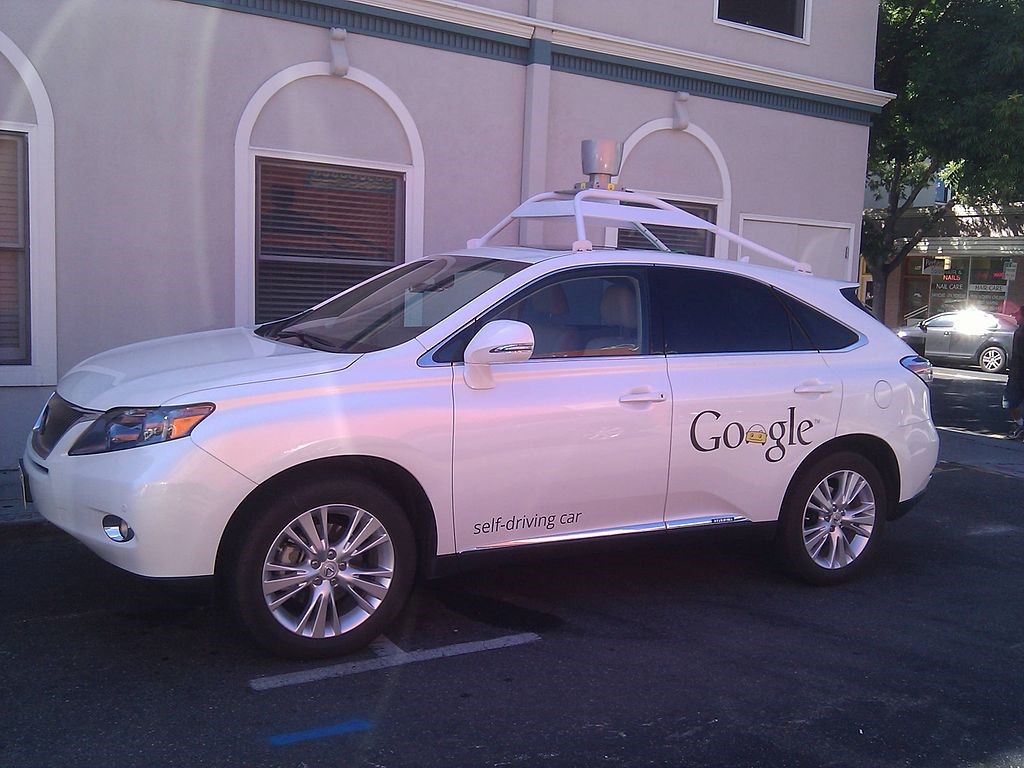
New cars help you stop faster to avoid accidents, stay in your lane, or even parallel park.
And these are just the beginning. We’ll see more automation features roll out as they’re proven to improve safety and stop death on the roads.
How do all these car safety features work?
… Tiny supercomputers are the secret.
Not only that, if you’re in certain cities in the US, you could have a pleasant surprise the next time you’re looking for a parking spot.
Because new apps are being created that can help you find and grab the best open spot, using real-time tracking of which spots are available, with sensors built into streetlights. And again …
… Tiny supercomputers are the secret.
There’s over $6 trillion worth of commercial property that’s beginning to be retrofitted with smart building tech that saves money and increases profits ...
Lighting changes based on whether or not people are in the room, and how much natural light there is. Temperature is adjusted on a space-by-space basis to lower energy costs while increasing comfort.
… Tiny supercomputers are the secret.
And every single one of these examples stands to put more profits in your pocket, with just one investment in a tiny $5 company.
I could go on ...
- There are the streets in America that use tiny supercomputers to “sense” car accidents and gunshots the moment they happen. And get first responders there faster, without waiting for a 911 call …
- America’s $1.4 trillion logistics industry is rolling out tiny supercomputers to track every plane, train, and automobile — and every valuable load and package they carry ...
- Heck, there are even airports using tiny supercomputers to track and manage their 15,000 on-site vehicles, where they are, where they’re going, and who is driving — to keep travelers safe and on-time …
And we’re just scratching the surface.
In all of these cases, tiny supercomputers are allowing us to do incredible things today that would have been impossible even 5 or 10 years ago.
That’s what’s driving such rapid adoption.
52% of companies have already started integrating tiny supercomputers into their operations. And we’re not just talking retail — this is across all industries, according to a recent Ziff Davis survey of tech professionals.
This is creating
massive new wealth …
Consider this. Retail shows us exactly how this technology is being adopted so quickly.
Amazon Go’s PR push is getting the world acquainted with the idea of Retail 2.0. Cashierless shopping — shopping without even stopping to check out — will quickly become the norm.
But their 3,000-store launch is less than 1/10th of 1% of the total retail industry.
America’s 3-million-plus retailers are paying attention. And they’re now in a race to get their hands on this technology.
It’s how they’ll survive and thrive in the next decade.
Companies like Standard Cognition, Zippin, AiFi, and Trigo Vision are all creating platforms for retailers to “plug and play” tiny supercomputer technology into their current operations. And that’s just the beginning.
Even Walmart is getting in the game, testing the tech in a cashierless Sam’s Club store in Texas.
Every industry has pioneers like Amazon Go that are already proving the power of tiny supercomputers in their business. And right behind them are a thousand solutions to roll out tiny supercomputers on a mass scale.
That’s what’s triggering such rapid adoption today. And what will drive massive growth for the next decade.
And the $5 stock I’ve identified will be at the center of it all – because their hardware plays a vital role in making these solutions work.
The question is not
“Which businesses will go Retail 2.0?”
… but rather, “How fast?”
We’re at that point in the tech growth curve right before this technology goes exponential.

There was a point with computers where only tech geeks and true forward-thinkers had anything to do with them. Now, from our phones, to our TVs, to our actual computers, to our tablets, to our cars, to — we could insert 1,000 more examples here — we’re constantly interacting with computers.
And each example made a fortune for those who invested ahead of the curve.
Retail 2.0 technology — and tiny supercomputers — will work the exact same way.
The tiny supercomputers themselves have just become powerful enough and affordable enough to start making a massive business impact …
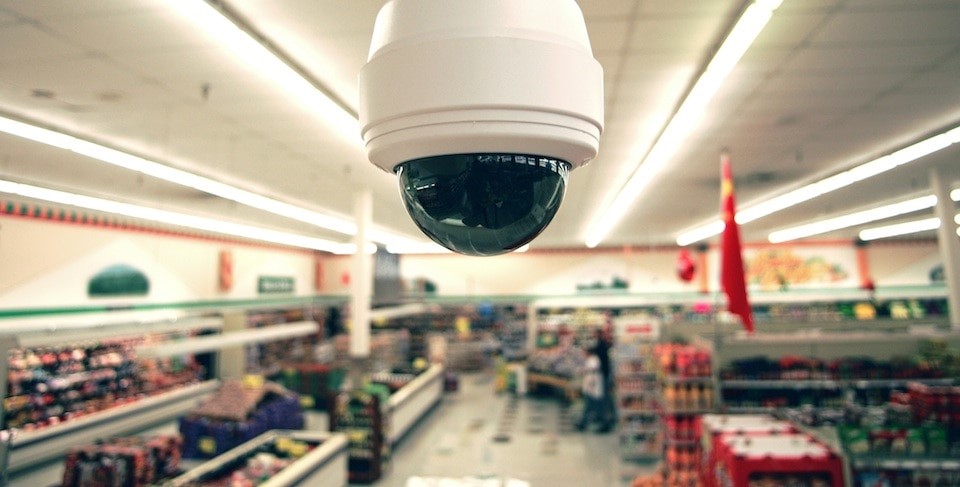
- To be able to watch the equivalent of security camera footage …
- Analyze that video, on the fly, to see what a shopper picks up and what they do with it …
- And hold what the shopper is taking in a “virtual cart” for them, until they exit the store …
Within a couple short years that experience will describe your local corner store, your local grocer, airport shops, mall stores, and just about any other retail establishment.
And as the tech develops, the experience will only get better.
Within the next 5 to 10 years, this will completely change the face of American retail. It will drive massive wealth back to Main Street America.
And it could make you rich — if you act now.
Because before you go to bed tonight, you will know which tiny $5 stock to buy. So you can go for your piece of the profits that will be generated by this next major tech revolution.
And this same tiny supercomputer investment will pay off far
beyond Retail 2.0 …
Smart cities. Smart cars. Smart airports. Smart factories. Smart office buildings. Smart shipping networks.
We’re just getting started.
So much of modern life is going to be transformed — and every example points to yet another profit opportunity.
Take train locomotives, for example. They’re being equipped with the latest tiny supercomputer technology.
As the train rolls down the track, it analyzes track conditions, using an algorithm that can identify potential failure spots. And as it rolls into a railyard, all its parts are analyzed by cameras and tiny supercomputers, too.
Using this seemingly futuristic tech, the railroads are able to make predictive repairs. In other words, fixing things before they actually fail.
Not only is this safer, it’s also far cheaper. After all, it costs far less to fix a section of track before it fails, instead of after when you’re also cleaning up a massive train wreck.
This technology already exists — and the railroads are investing heavily in rolling it out. Union Pacific alone is investing more than $2.5 billion.
This same tiny supercomputers revolution is taking place in industry-after-industry.
- Agricultural irrigation systems that reduce cost and increase yield by putting more water where it’s needed, and less where it’s not …
- Health sensors that can track a patient’s vital stats — and catch illness early, in time for better, more focused treatment …
- Even factories that run safer, catch more defects, and deliver better products, thanks to constant monitoring through complex AI algorithms …
All driven by the same technology.
Which is why the best way to play this revolution is with the tiny $5 stock whose hardware is absolutely critical to rolling out tiny supercomputers in every industry.
Thinking BIG
will yield the biggest profits …
If you want a piece of this action, think beyond the San Francisco startups duking it out to offer the best Retail 2.0 platform.
Think beyond the behemoth Amazon, already so big that 3,000 or even 30,000 convenience stores would barely make a blip on their stock chart.
In fact, think beyond the retail sector entirely.
Consider: every camera, sensor, and tiny supercomputer has to send data back and forth. Not only that, they all have to be linked up to the internet, to cloud-based applications, and data centers.
As of 2018, we passed 10 billion connected devices. That’s more than one connected device per person.
By 2030, it’s expected we’ll have over 125 billion total connected devices. That’s more than 14 devices connected to the internet, for every person on the planet, according to the latest research published in Forbes.
These 125 billion devices will NOT be wired.
Sure, in some scenarios — like retail — you could wire up the cameras and sensors to the on-site tiny supercomputers. And yet, why rip out the walls and ceiling and completely disrupt the store, when wireless tech can be installed faster, easier, and completely affordably?
But the reality is that most use cases of tiny supercomputers are places where wires make zero sense. That train rolling through the station? Wireless. Smart cars, smart streets, and smart cities? Wireless. Smart airports? Also wireless.
The examples could go on, because much of the “magic” of this tiny supercomputer technology is that it can go anywhere.
The biggest need is in
connecting the tiny supercomputers …
No matter the industry … No matter the application … No matter the other tech used … No matter the AI algorithms that are being run on the tiny supercomputers …
They all have to talk to each other.
And that’s where we could grab profits of up to 18-times our money, if not a lot more.
Cisco wired up the world’s computers through the 1990s. With even a little foresight into the roll-out of computer networking, you could’ve turned $10,000 into as much as $4 million, cash.
We’re about to see 125 billion devices, communicating wirelessly.
The tiny supercomputers. The cameras. The other sensors. All talking to each other. And all communicating with the cloud.
This is an opportunity for
“the next Cisco …”
That is, the next company that can help every one of these devices communicate back and forth.
A company that specializes in helping all these devices talk to each other …
… Whether it’s the cameras in the ceiling and the sensors on the shelves of your local retailer …
… Or planes, trains, and automobiles that are moving all those goods around …
… Or even the parking spot tracking systems in smart cities …
As all these tiny supercomputers start to talk to each other, you’ll want to be invested in the company that makes that easy.
This $5 stock could soar to $90
and beyond …
I’ll give you that link in a moment, so you can grab shares of this stock. First, here’s what you really need to know ...
This company is not a household name — yet.
And, in fact, I hesitate to even mention them in a presentation like this. Because it’s a smaller company. Their current market value is just north of $350 million, looking at a multi-trillion-dollar market.
And at just $5, a little investor interest could send share prices up, quick.
In fact, that’s part of why I like them so much as a way to play the rollout of tiny supercomputers in Retail 2.0 and beyond.
Not just because they have the tech needed.
But because they represent a massive wealth windfall opportunity for investors with the foresight to get in now.
Just like Cisco made a fortune helping desktop computers talk to each other, this company stands to deliver huge returns as these tiny supercomputers are connected.
Their tech is
already being rolled out
throughout the Fortune 500 …

Take gas stations, for example. Gas stations and convenience stores are at the front lines of Retail 2.0. Through a special partnership, this company’s tech is already being installed nationwide, at the gas stations of a Fortune 500 retailer. It’s working behind the scenes, connecting cameras, sensors, fuel pumps, payment systems, and more.
This company has also partnered with one of America’s largest cellular networks. So for businesses (or consumers) who need a mobile connection for their tiny supercomputers, you can get that today. This is especially important for the $1.4 trillion logistics industry, tracking vehicles, and loads as they criss-cross the country.
They’re also helping to create smart emergency vehicles. Police cars, fire trucks, and ambulances. Their tech is helping our first responders be more effective and safer while doing their important work.
And then there’s smart airports, powered by tiny supercomputers. Fleet vehicles. Smart electrical grid technology. Lighting and climate control in buildings, designed to cut costs, and increase profitability.
Partner after partner are lining up to grab this company’s tech and implement it as a keystone element within their tiny supercomputer networks.
Their tech is about to go mainstream
— so the time to invest is now …
As I mentioned, at just over $250 million in market cap, this is a relatively small stock.
If I were to shout my recommendation for this $5 stock from the rooftops, it would create too much trading volume. It could spike share prices big-time. I’d prefer to let that happen more naturally, as their tech rolls out.
Which is also why I can’t go write an article for Forbes singing the praises of their tech.
But from inside the industry, I see the growing demand for their solutions.
Industry shows are hosting special demos. Vertical markets are giving leadership awards to their platform. And they’re landing contracts and partnerships across the industry to roll out their tech. These are signals you look for to know which tech is about to win big.
This is already translating into stock market gains, too.
In 2018, the market took many stocks on a roller-coaster ride and many tech stocks ended down, hard …
NVIDIA, another darling of the AI revolution, saw their share price get cut roughly in half near the end of 2018.
Apple fell by more than a third. Amazon was down more than 35%.
The Nasdaq as a whole dropped nearly 2,000 points off its highs.
And yet, even with all those tech stocks down …
This stock has already doubled in value,
and that’s just a start …
This stock went from under $2 to around $5 during 2018 and held on to those gains while the rest of the tech market stumbled.
That’s a sign of incredible strength.
And even though we’ve seen the stock more than double already, I still believe investors who buy today could see as much as 18X gains in this stock, if not more.
But you can’t wait around for this.
Not only has this stock already doubled — the kind of demand that will keep moving their stock higher is building today, as more and more companies integrate tiny supercomputers into their business models.
Smart retail. Smart homes, offices, and cities. Smart agriculture. Smart utilities. Smart healthcare and factories. Smart utilities. Smart transportation.
Solutions in every sector, being rolled out at a rapid pace.
And it’s always the investors who get in at the front of a wave like this who enjoy the biggest payday.
Here’s how to grab
my full analysis …
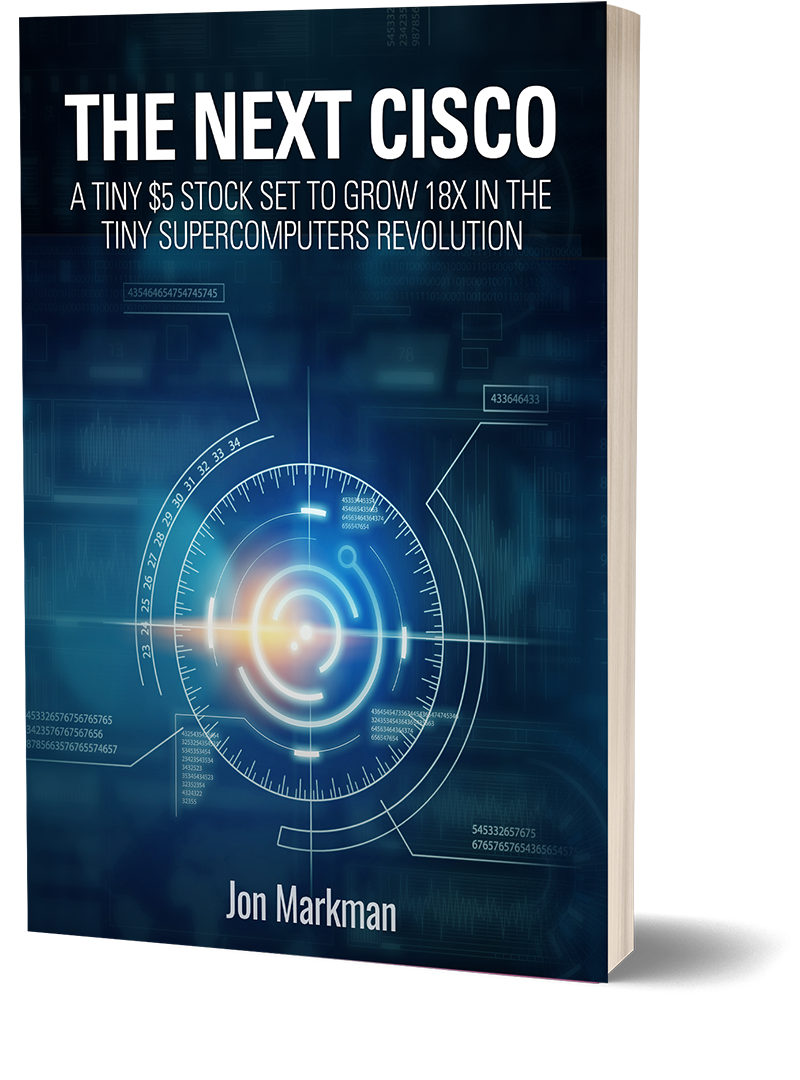
I’d like to send you a link to download my report on this stock. It’s titled, The Next Cisco: A Tiny $5 Stock Set To Grow 18x In The Tiny Supercomputers Revolution. This report alone is easily a $79 value, but I’d like to give it to you for free.
Inside the report, you’ll find my full write-up on this stock, including the company ticker and specific buy recommendation.
I see this as the biggest opportunity of the next decade.
Bigger than 5G. Bigger than AI. Bigger than the Internet of Things.
The Retail 2.0 transformation will be one obvious sign that tiny supercomputers are rolling out everywhere. But it just scratches the surface of all the wealth set to flow into this industry, and into our pockets as shareholders.
I’d like you to be a part of it. And yet, I must restrict distribution.
As I said, this is a $5 stock, with a small market cap of just about $250 million. If my report stimulates too much trading activity, too fast, we could cause prices to spike, which I DO NOT want.
Which is why I have to restrict distribution of this report …
You get the link to this 18X opportunity
if you’re in the first 250
to reply to this offer today ...
I offer a monthly investor intelligence service called The Power Elite. And if you are one of the first 250 to agree to try it risk-free and without obligation for the next 12 months, you’ll get that link and immediate download access to my report on The Next Cisco.
Let me explain The Power Elite ...
The top 30 stocks generate 50X the profit of everything else.

In my three decades in investing and tech, I discovered an interesting phenomenon in the markets. Namely, that just 30 stocks create ⅓ of all new wealth.
That’s $300 million in new wealth, every day.
The average stock in the top 30 stocks generates $10,000,000 in new wealth, daily. The average of all the other stocks in the market is a mere $175,000.
That’s 50 times the wealth-building power.
I understood this on a gut level many years ago.
It’s part of what I built into the world-famous StockScouter algorithms as part of MSN Money.
But recent research out of Arizona State University’s W.P. Carey School of Business gave me even more proof. In fact, they proved it’s been true for over 90 years — since before The Great Depression!
Through bull and bear market — the principle holds true — the top 30 stocks create a hugely disproportionate amount of wealth for their shareholders.
Now, it makes great academic research to look backwards. But as an investor, you need to look forwards.
You need to understand which 30 stocks you can buy TODAY that will generate 50 times the wealth tomorrow.
The Power Elite is the ONLY source
for my exclusive research on
today’s top 30 wealth-builders ...
For a company to fit in The Power Elite, two big things need to be true …
First, they have to be a part of the right trend — like the rise of tiny supercomputers. This is a large reason why I’ve disproportionately focused on tech investing over the last three decades. Yes, I’m a computer geek. But tech is creating more new wealth than any other segment of the economy. So that’s where I look for investments.
And second, they have to be great companies. I’m not going to go into it here, but there are a mix of fundamentals and technical factors I look for when deciding what to buy and when. I’ve continued to refine my algorithms since the 1990s to only invest in the best companies, at the best time.
This is what I’m looking for when I’m analyzing which 30 stocks will be the biggest wealth creators this week, this month, this year, and this decade.
This is how I found the tiny $5 stock I want to link you to today. And this is the research and analysis that I distill into actionable advice and a focused investment portfolio in The Power Elite.
Try The Power Elite for
the next 12 months ...
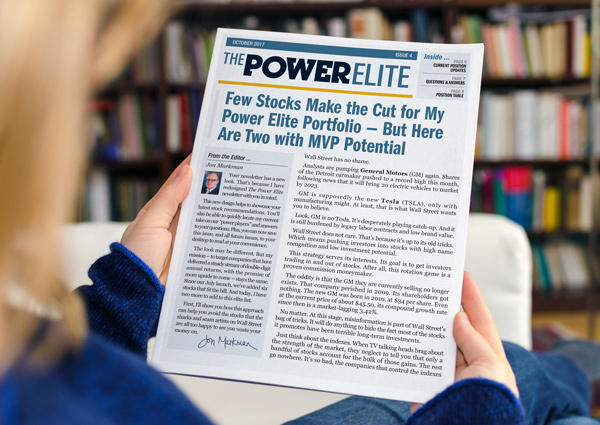
Every month, I’ll bring you specific advice on the best moneymaking investment opportunities I find.
Plus, every issue will give you my latest insights into the markets and its impact on our The Power Elite stocks. Plus, you’ll get the latest news on all the companies we’re following, with any steps you need to take clearly explained.
In addition, as a Power Elite member, you’ll get access to a private members-only website, through my publisher Weiss Ratings. This website gives you anytime access to all the member benefits, including recent recommendations in the issue archives.
Inside the members-only website, you’ll also find our portfolio and position tracker, giving you the very latest recommendation on every stock in The Power Elite.
You’ll also find a library of special reports — including The Next Cisco: A Tiny $5 Stock Set To Grow 18x In The Tiny Supercomputers Revolution — that cover the most important opportunities in the market. Trends and specific investment recommendations I’ve made to tap into the rapid wealth-building power of The Power Elite.
Plus, you’ll get my regular commentary into the most interesting trends and opportunities in tech and beyond, in my free Markman’s Pivotal Point email letter, delivered every Monday, Wednesday, and Friday.
Here’s how to get started ...
The official retail rate of The Power Elite service is $228 per year — and a bargain at that. If you only joined to grab the link to the $5 tiny supercomputers play and ignored me for the next 12 months, you could still see a massive return on a $228 investment.
But because of your interest in tiny supercomputers, I’d like to offer you an even better deal.
If you’re one of the first 250 to respond to my offer today, you’ll get the link to instantly access my report on The Next Cisco: A Tiny $5 Stock Set To Grow 18x In The Tiny Supercomputers Revolution ...
Plus, you can get your first 12 months of membership for just $29.
That’s $199 off and more than 87% savings from the retail price.
Not only that, it’s risk-free …
You’ll have 12 months to profit —
or your membership is free ...
I want you to try all the member benefits of The Power Elite for the next 12 months.
Get the monthly newsletters. Log into the website. Follow the portfolio.
Download The Next Cisco: A Tiny $5 Stock Set To Grow 18x In The Tiny Supercomputers Revolution and any of the other exclusive reports for members.
And start to enjoy your own windfall profit opportunities from The Power Elite.
If you decide at any time within those next 12 months that you’re not grabbing enough profits — or are not 100% satisfied for any other reason — simply let our member services team know.
Again, you have until the very last day of your 12-month subscription to decide.
If you let member services know at any time in the next 12 months, they’ll rush you a prompt and courteous full refund of your entire $29 membership fee.
And whether or not you decide to stick with us, you can keep my full research into The Next Cisco as my thank you for giving the service a try.
Join today, and I’ll link you to
one more tiny supercomputers play …
If you think about your local corner store and wonder who is going to install their Retail 2.0 solution, you can bet it’s not the cashier. Or the store owner. Or the stock clerk.
You can bet it’s going to be outsourced. To a third-party solution provider who already helps them with their tech.
There’s one select company in The Power Elite that specializes in bringing tomorrow’s technologies into retail, plus nine other specific verticals.
They create the tech solutions. They source the hardware. They install the software. They get the solution set up. And then they get paid on an ongoing basis to manage it, so the store owner and employees can be mostly hands-off.
This company started in the 80s and has grown to a multi-billion dollar tech service provider through keeping their clients up to date with the latest profitable tech solutions.
This has also paid off for investors.
Over the last five years, their stock has increased in value more than 4X …
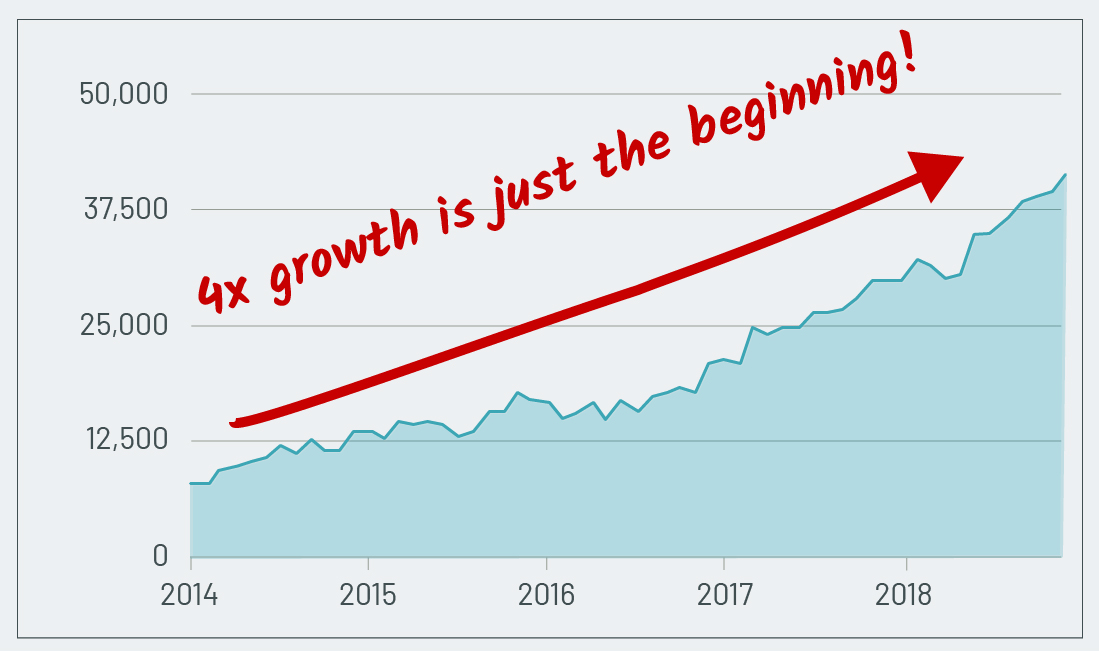
And note, while most of the tech sector suffered in late 2018, their stock continued to climb.
I think this could multiply your money 4X again, and then some. Simply because their services will play a critical role in helping so many other businesses profit from the tiny supercomputer revolution.
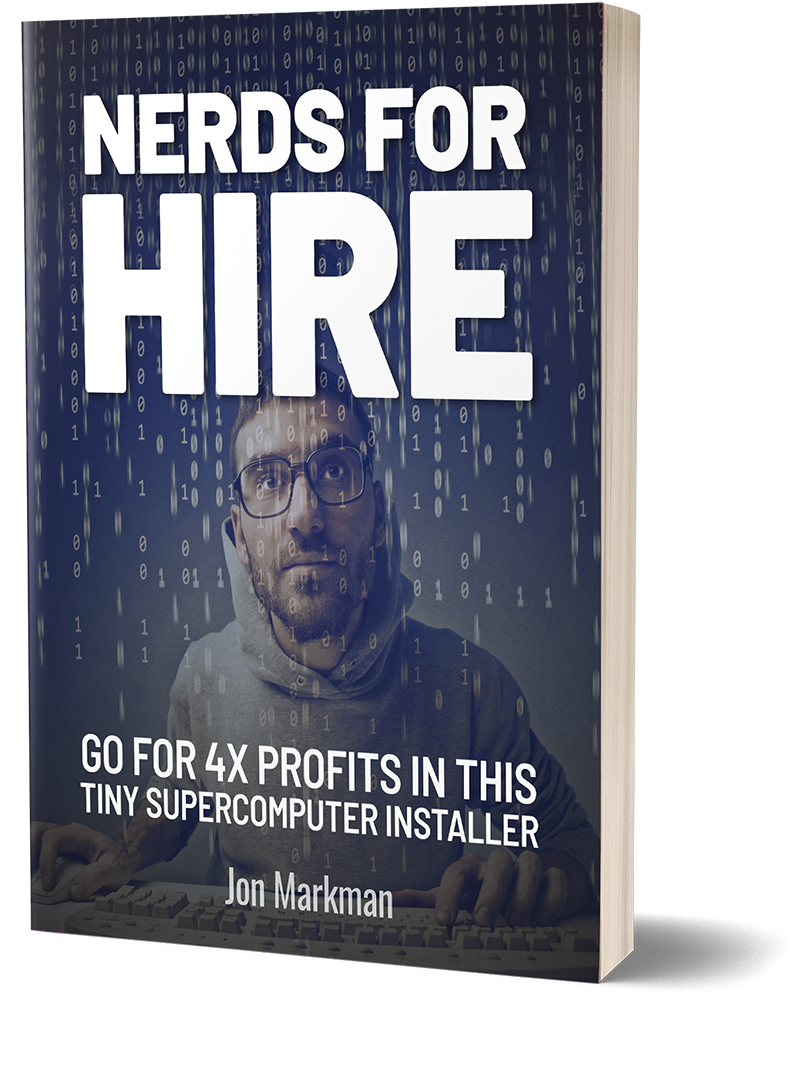
I’ve written up my recommendation for this company in another special report I want to link you to today. The report is (lovingly) titled, Nerds for Hire: Go for 4X Profits in this Tiny Supercomputer Installer. And if you respond to my 12-month offer to try The Power Elite today, you’ll also get a link to download this right away.
This is not a “Wait and See” opportunity ...
I’ve shown you the proof. I’ve likely revealed to you a handful of ways tiny supercomputers are now being used that you weren’t aware of. And I barely scratched the surface.
As Amazon Go opens up store-after-store … As other retailers get Retail 2.0 tech installed … As you start to see signs of all these tiny supercomputers doing their thing everywhere …
There will be 1,000 other applications of tiny supercomputers that will be practically invisible to you. Unless, for example, you work in a rail yard or at an airport and see them impacting your work.
But the nature of these tech revolutions is that you can’t wait to invest until you see them “in the wild.”
The biggest profits in every example I gave above came from being there BEFORE the tech became ubiquitous …
- 6,000% gains in Microsoft …
- 24,000% growth in Cisco …
- 15,600% gains in Amazon …
- 1,800% growth in Salesforce …
- 7,500% gains in Nvidia …
That’s what will likely happen with tiny supercomputers, too.
Take action NOW
and I’ll send you the links …
Grab one of the first 250 spots today …
You’ll get the link for instant download access to The Next Cisco: A Tiny $5 Stock Set To Grow 18x In The Tiny Supercomputers Revolution.
You’ll get the link for Nerds for Hire: Go for 4X Profits in this Tiny Supercomputer Installer.
You’ll get instant access to the members-only website for The Power Elite, with all your member benefits.
You’ll get 12 monthly issues of The Power Elite, keeping you on top of the best profit opportunities in the tiny supercomputer revolution, and the market’s top 30 wealth-creators.
You’ll get all of that risk-free and without obligation.
And you’ll be locking in an 87% savings — knowing full well that we only keep your membership fee as long as you’re fully satisfied with the profits you are delivered through The Power Elite.
No risk, no obligation …
Up to 18X profits …
As long as you act now.
Click on the Get Started Now button below and you can review all the details before starting your service.
Or call customer service at 877-934-7778
(Overseas, call 1-561-627-3300)
I look forward to welcoming you to The Power Elite and sharing my best profit opportunities with you over the coming 12 months.
Sincerely,

Jon D. Markman
Senior Analyst, Weiss Ratings
Editor, The Power Elite
